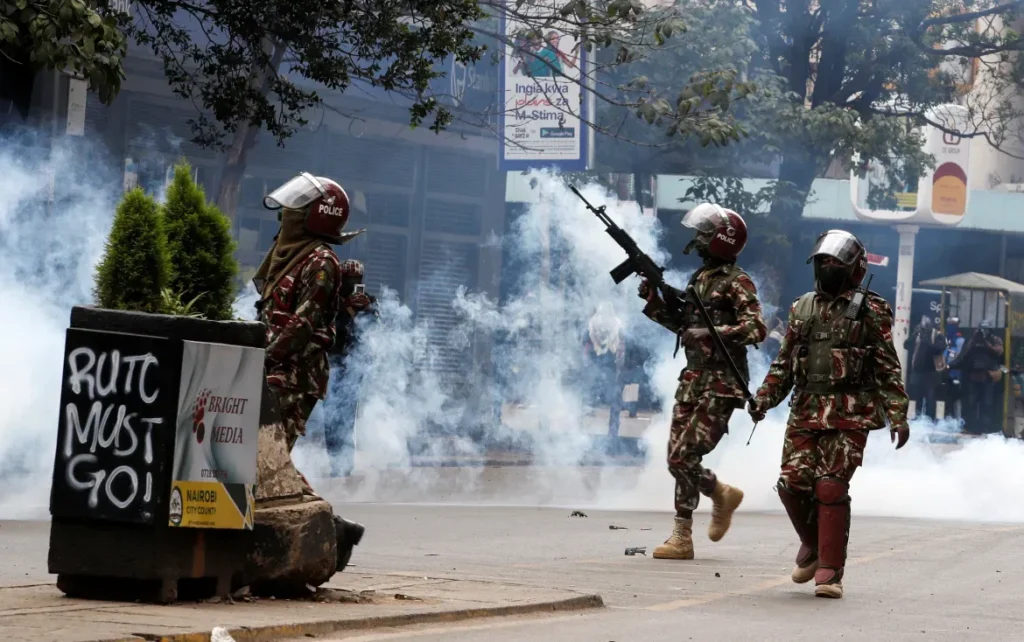In Summary
- On Thursday, Kenyan police used tear gas against protesters in Nairobi demanding President William Ruto’s resignation. The demonstrations occurred as a new cabinet was being sworn in, despite the president’s recent dismissal of almost all his ministers and the inclusion of opposition members in his government.
- Businesses in Nairobi were largely closed, and public transport vehicles stayed out of the central business district. Police set up roadblocks leading to the city, and the president’s office, where the swearing-in ceremony took place, was heavily guarded.
- Major towns and cities, including Kisumu, an opposition stronghold, remained calm, with residents citing the inclusion of opposition figures in the new cabinet as a reason for not protesting.
- Civil society groups and the Law Society of Kenya issued a joint statement urging the upholding of human rights during demonstrations and calling on the police to avoid using non-uniformed officers and unmarked vehicles.
- The protests began on June 18, initially opposing a controversial finance bill that proposed tax increases amidst a high cost of living. After the bill was passed by parliament, protests escalated, leading to over 50 deaths, according to the Kenya National Commission on Human Rights.
- President Ruto refused to sign the finance bill and returned it to parliament, acknowledging public opposition. However, he warned of potential revenue and expenditure consequences. Despite dismissing nearly all his ministers, protests demanding his resignation due to alleged bad governance, corruption, and lack of accountability have persisted.
NAIROBI, KENYA– Kenyan police deployed tear gas against protesters in the capital city of Nairobi on Thursday as they called for President William Ruto’s resignation. The protests coincided with the swearing-in of a new cabinet, a move by Ruto that included dismissing nearly all of his ministers and integrating opposition members into what he described as a “broad-based” government.
The demonstrations, organized by activists dissatisfied with the president, led to widespread closures of businesses across Nairobi. Public transport vehicles, which typically operate in the bustling central business district, stayed out of the area as police erected roadblocks on key routes into the city. The president’s office, where the new ministers were officially sworn in earlier in the day, was heavily secured and cordoned off to prevent any disruptions.
While Nairobi saw significant unrest, other major towns and cities, including Kisumu—an opposition stronghold that has a history of protests—remained relatively calm. Some residents in these areas reported that they chose not to participate in the protests due to the opposition’s inclusion in the new cabinet, which seemed to alleviate some concerns.
Amidst the unrest, civil society groups and the Law Society of Kenya jointly called for the protection of human rights during the demonstrations. They urged the police to avoid using non-uniformed officers and unmarked vehicles, practices that have previously led to heightened tensions and concerns over accountability.
The protests in Kenya trace back to June 18, when public outcry first erupted against a controversial finance bill that proposed increased taxes during a time of economic hardship. The situation escalated on June 25 when protesters stormed parliament following its approval of the bill. According to the Kenya National Commission on Human Rights, the demonstrations have since resulted in over 50 deaths.
President Ruto, responding to the widespread discontent, declined to sign the finance bill and sent it back to parliament, acknowledging the strong opposition from Kenyans. Despite this, he cautioned that rejecting the bill could lead to significant revenue and expenditure challenges for the government. However, the protests continued, with demonstrators shifting their focus to broader issues, including demands for Ruto’s resignation over accusations of bad governance, corruption, incompetence within his cabinet, and a lack of accountability.
https://www.africanexponent.com/cabinet-swearing-in-tear-gas-deployed-as-protests-against-president-ruto-erupt-in-nairobi/


